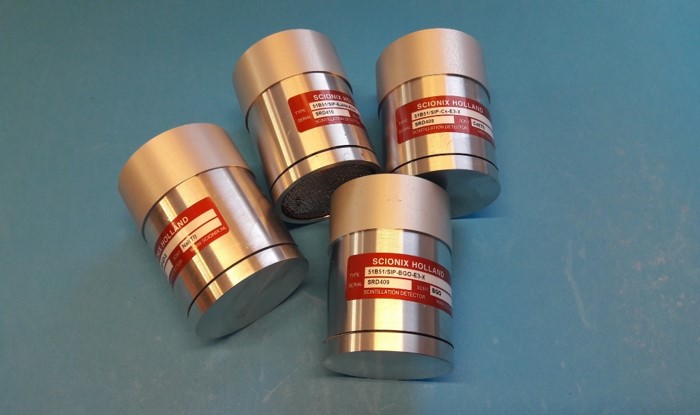November 17th, 2020 - The History of Scintillation Detectors for Gamma Spectroscopy
Berkeley Nucleonics offers a wide range of custom and standard scintillators including Sodium Iodide, Cesium Iodide, and Lanthanum Bromide.
In 1948, Robert Hofstadter found that sodium iodide, with a trace of thallium added to the melt, produced a large scintillation light output with gamma radiation. This event marked the beginning of organic scintillation gamma spectroscopy which has markedly improved over the years. Today sodium iodide thallium, NaI (Tl), is still the most popular scintillation material primarily because of its extremely good light yield, high stopping power (high atomic number-53) and excellent linearity.
Sodium Iodide (Tl) Scintillators
Thanks to good research in crystal growing techniques over the years, large crystals are commonly produced today with good resolution (typically 7% @ 662 keV, FWHM) giving excellent efficiency and photofraction. Today very large detectors are achieved with dimensions of 4x4x16 inches and greater. Special shapes and arrays are useful for Compton suppression (continuum reduction) and experimental configurations to meet a specific requirement. These special needs can be discussed with BNC for your unique application.
High Resolution Scintillators
The quest for higher energy resolution scintillators has resulted in many relatively new materials. In 2001 the first lanthanum bromide (LaBr3:Ce) was produced and quickly became popular with an energy resolution of 3% @ 662 keV, FWHM. The main drawback of this detector is the high background from the La-138 contaminant. This intrinsic background can cause a factor of 100 or more in background continuum over that of NaI(Tl). High intrinsic background greatly reduces the detector sensitivity across the spectrum.
Cerium bromide (CeBr3) scintillators were introduced at the IEEE Nuclear Science Symposium in 2004 and has been an excellent choice for high-resolution scintillators in recent years. It has low intrinsic background similar to NaI(Tl) that allows high sensitivity across the spectrum. This is an advantage when the external background is high and the source is shielded or is some distance away. The resolution for CeBr3 is 4% @ 662 keV, FWHM. These fully encapsulated detectors are readily available from BNC in 2x2 inch crystals and larger. More details on this detector can be found in the article entitled “The Performance of CeBr3 Detectors” on the BNC website.
Silicon Photomultipliers for Scintillation Spectroscopy
Scintillation crystals, primarily cesium iodide, have been used with SiPMs for many years. By 2014 many papers reported SiPMs being recognized as the detector of choice for various applications requiring good energy or time resolution. Various scintillation crystals can be produced mounted in a hermetically sealed metal container. The obvious advantage of the scintillator/SiPM is greatly reduced space with elimination of the photomultiplier tube and significant power savings for portable use. The new generation scintillator/SiPM detectors are compact operating with bias voltages as low as 5 volts. Please consult BNC for details.
An even newer scintillator, cesium lanthanum lithium bromochloride (CLLBC) is available in 2x2 inch crystals. The energy resolution is about 3% @ 662 keV, FWHM and is a dual mode detector for both gamma spectroscopy and neutron detection. The addition of lithium provides a sharp thermal neutron peak between 3.1 and 3.2 MeV. These scintillation detectors and many others (e.g. CLYC) are available and can be discussed with BNC for your specific application.
Please feel free to contact Berkeley Nucleonics at info@berkeleynucleonics.com or (800) 234-7858 to learn more about these exciting developments.


